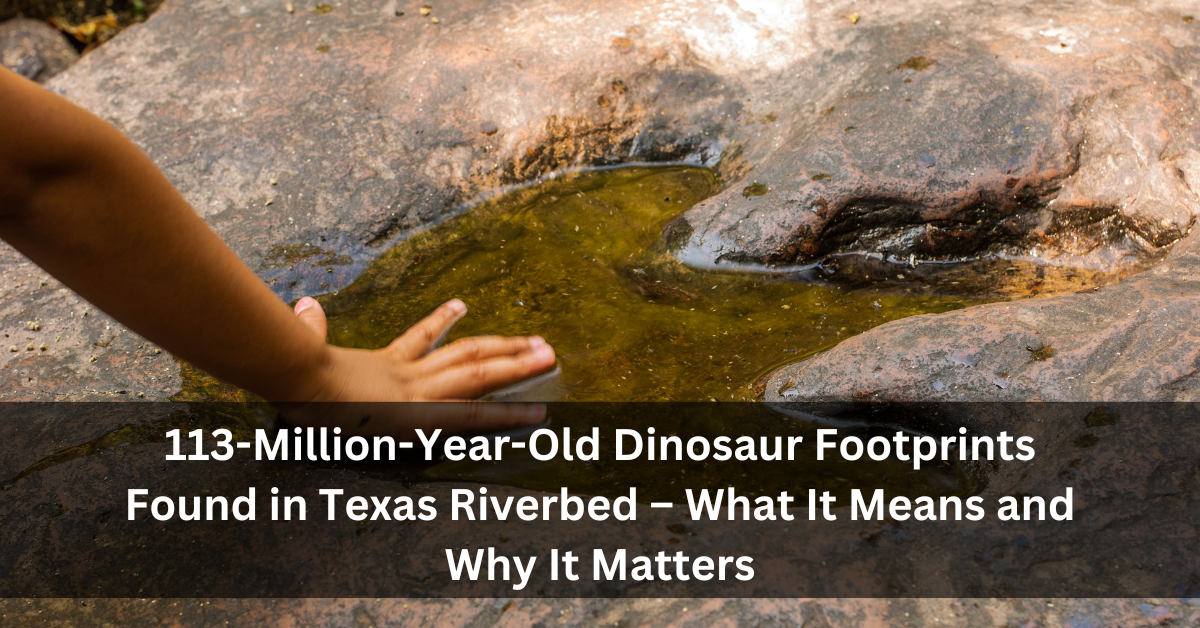113-Million-Year-Old Dinosaur Footprints Found in Texas Riverbed – What It Means and Why It Matters
A recent finding in the United States has amazed people across the world. In the state of Texas, very old dinosaur footprints have come to light after a part of a riverbed dried up. These footprints are believed to be around 113 million years old. That’s much older than any human history we know. This surprising discovery has once again brought attention to how much we still have to learn about the Earth’s past.
This news was shared widely by global media, and here at Blogs, we think this is an exciting and meaningful story to talk about.
How Were the Footprints Found?
In Texas, there is a place called Dinosaur Valley State Park, located near the Paluxy River. Due to a long dry spell and lack of rain, parts of the river dried up. When the water disappeared, something surprising appeared on the riverbed—dinosaur footprints that had been hidden under mud and water for many years.
These footprints are from two dinosaurs. One was a meat-eater called Acrocanthosaurus, and the other was a plant-eater named Sauroposeidon.
Who Were These Dinosaurs?
Acrocanthosaurus was a large dinosaur that walked on two legs. It stood about 15 feet tall and weighed as much as 7 tonnes. Its footprints show three sharp toes, and the marks look quite scary. This dinosaur was a hunter.
Sauroposeidon was the opposite. It was one of the tallest dinosaurs ever found, over 60 feet in height and very heavy. It walked on four legs and ate plants. Its footprints are round and wide, showing how heavy and slow-moving it must have been.
The tracks are clear and well-preserved because they were made in soft mud millions of years ago. That mud later turned into hard rock, locking the footprints in place. Over the years, natural forces covered them with water and dirt—until the drought made them visible again.
Why Is This Important?
These footprints give scientists a rare chance to understand how dinosaurs lived, how they walked, and even how they behaved. For example:
- If the footprints are very close to each other, it can mean the dinosaur was running or chasing something.
- If two types of footprints are near each other, it may show that one dinosaur was following another.
Scientists also study the depth, shape, and pattern of the tracks to learn more about how these creatures moved and lived. This is why the discovery has become big news not just in the U.S. but also in countries like India.
What’s Being Done to Save These Prints?
The footprints are currently being studied by experts and photographed for record-keeping. Once the river starts flowing again, these tracks will be naturally covered by mud and water. That’s actually a good thing because it protects the prints from getting damaged by wind, rain, and people stepping on them.
Park officials have said they don’t want to dig them out permanently. Instead, they want to let nature take care of them until the next time drought brings them back.
Such stories are shared on Blogs to help more people understand the importance of protecting natural and historical places.
Why Should Indians Care?
This might have happened far away, but it’s a great reminder for us in India too. Our country has many important fossil sites. One well-known place is Balasinor Dinosaur Fossil Park in Gujarat. Fossils of dinosaurs have been found there, and it’s considered one of the biggest dinosaur sites in Asia.
India also has remains of dinosaur eggs, bones, and even footprints. But sadly, many people are not aware of this. When stories like the one from Texas are shared widely, it encourages interest in protecting our own historical places.
Schools in India can use these stories as fun and meaningful learning material. It’s much easier for students to connect with history when they read stories like this in simple words—just like we try to write here on Blogs.
Public Reaction
As soon as the news came out, people started sharing it online. Photos of the footprints were shared on many social media platforms. Some people called it a “real-life Jurassic Park,” while others simply couldn’t believe how clearly the tracks were preserved.
Visitors to the park were excited to see something so old with their own eyes. Scientists from across the world started to show interest in studying the prints before the river covers them again.
Can You Visit the Site?
Yes, the Dinosaur Valley State Park in Texas is open to the public. While you might not always see the tracks—because they’re only visible when the river is dry—you can still see other signs of dinosaurs there. There are also models and guides to help people understand what dinosaurs lived in that area.
This is just another reason why following Blogs is helpful. We bring such interesting stories in easy-to-understand language for Indian readers who want to learn more.
Final Thoughts
Finding footprints that are 113 million years old is rare. It tells us a lot about the world before humans. These tracks connect us to a time when the Earth looked completely different. Such discoveries make us think about how nature stores stories in hidden corners.
At Blogs, we think it’s important to talk about these findings in simple language, so more people can understand and appreciate them. Whether it’s news from another country or our own, stories about nature, science, and history help us see the world in a different way.
So next time you hear about a fossil, a dinosaur, or an ancient site—remember that there’s a whole story behind it, waiting to be told. And we’ll be here to share it, right on Blogs.







